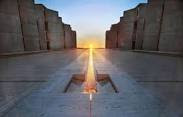On a recent visit to the San Diego Museum of Art Paul and I saw an extensive
exhibit on the life and architectural works of Louis Kahn. It was titled The Power of Achitecture.
It included
over 200 objects related to Kahn's selected buildings and projects in the form
of architectural models, plans, original drawings, photographs, films and more.
With complex spatial compositions and a mastery of light, Louis Kahn's
architecture is regarded as a touchstone of 20th century modernism.
 |
| Kimball Art Museum, Ft. Worth, Texas. |
Louis
Isadore Kahn (born Itze-Leib Schmuilowsky) (March 5, 1901 – March 17, 1974) was
an American architect,[2] based in Philadelphia. After working in various capacities for several
firms in Philadelphia, he founded his own atelier in 1935. While continuing his private practice, he
served as a design critic and professor of architecture at Yale School
of Architecture from 1947 to 1957.
From 1957 until his death, he was
a professor of architecture at the School of Design at the University of
Pennsylvania. Kahn created a style that was
monumental and monolithic; his heavy buildings for the most part do not hide
their weight, their materials, or the way they are assembled. Louis Kahn's
works are considered as monumental beyond modernism. Famous for his
meticulously built works, his provocative proposals that remained unbuilt, and
his teaching, Kahn was one of the most influential architects of the twentieth
century. He was awarded the AIA Gold Medal and the RIBA Gold Medal. At the time of his death he was considered by some
as "America's foremost living architect."[3]
•
The Salk Institute, La Jolla, California.The two laboratory blocks frame a long view of the Pacific Ocean
accentuated by a thin linear fountain that seems to reach for the horizon. It
has been named "arguably the defining work" of Kahn.
 National Assembly Building in Dhaka, Bangladesh was Kahn's
last project, developed 1962 to 1974. Kahn got the design contract with the
help of one of his students at Yale Univesity who worked with him on the project. The Bangladeshi Parliament
building is the centerpiece of the national capital complex designed by Kahn,
which includes hostels, dining halls, and a hospital. According to Robert
McCarter, author of Louis I. Kahn, "it is one of the twentieth
century's greatest architectural monuments, and is without question Kahn's
magnum opus."
National Assembly Building in Dhaka, Bangladesh was Kahn's
last project, developed 1962 to 1974. Kahn got the design contract with the
help of one of his students at Yale Univesity who worked with him on the project. The Bangladeshi Parliament
building is the centerpiece of the national capital complex designed by Kahn,
which includes hostels, dining halls, and a hospital. According to Robert
McCarter, author of Louis I. Kahn, "it is one of the twentieth
century's greatest architectural monuments, and is without question Kahn's
magnum opus."
Another area in the museum highlighted art of the
20th century
 |
| Still-life with fish by Emil Filla |
The
first decades of the twentieth century witnessed a schism in the arts as
painters and sculptors in Europe and the Americas began to break with academic
traditions. Rallying under the banner of expressive freedom and an independence
from established institutions, these artists began to explore new social
realities, and the even more radical concept of a purely abstract art. Adding
to this transatlantic transmission of ideas was an unprecedented
internationalism. A new era of travel and communication would, for example,
lead Mexican modernist Diego Rivera to Paris. Conversely, wars, suffering, and
the dream of a new life led ever more European artists to emigrate to the
United States.
 |
| by Diego Rivera |
 |
| by Salvador Dali |
Tracing
a trajectory through a century of art, from the School of Paris to Surrealism
and Pop, the paintings and sculptures on view do not present a traditional
survey divided by national schools. Instead, this display combines artists from
Europe, the United States, and Latin America to highlight the international
aspects of modernism. In so doing, the installation showcases the special
strengths of the Museum’s collection of modern and contemporary art together
with a select group of loans.
 |
| by Frank Stella |
 |
| A collage with elements of Picasso'a Guernica |

 |
| Photo of Guernica by Picass |
 National Assembly Building in Dhaka, Bangladesh was Kahn's
last project, developed 1962 to 1974. Kahn got the design contract with the
help of one of his students at Yale Univesity who worked with him on the project. The Bangladeshi Parliament
building is the centerpiece of the national capital complex designed by Kahn,
which includes hostels, dining halls, and a hospital. According to Robert
McCarter, author of Louis I. Kahn, "it is one of the twentieth
century's greatest architectural monuments, and is without question Kahn's
magnum opus."
National Assembly Building in Dhaka, Bangladesh was Kahn's
last project, developed 1962 to 1974. Kahn got the design contract with the
help of one of his students at Yale Univesity who worked with him on the project. The Bangladeshi Parliament
building is the centerpiece of the national capital complex designed by Kahn,
which includes hostels, dining halls, and a hospital. According to Robert
McCarter, author of Louis I. Kahn, "it is one of the twentieth
century's greatest architectural monuments, and is without question Kahn's
magnum opus."










No comments:
Post a Comment